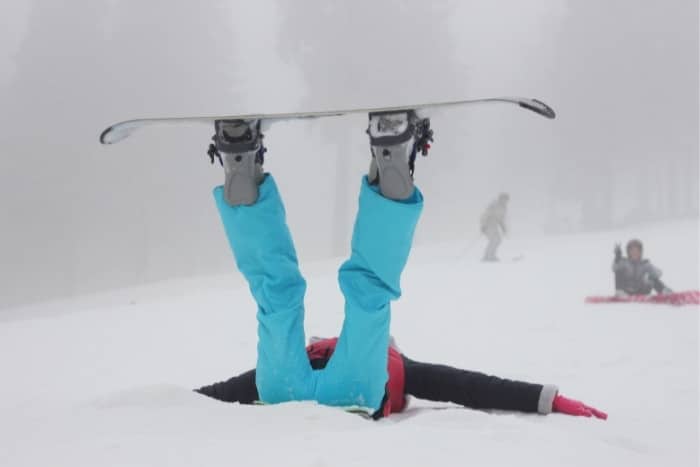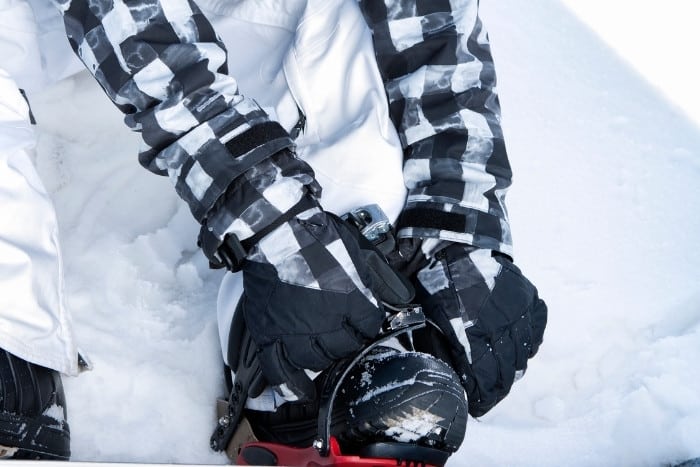Having optimum control while snowboarding is essential for your fun and safety. Your snowboarding skills play a large part in how much control you have, but a high skill level can be compromised by wearing snowboard boots that are too big for you.
When your snowboard boots are too big, you have less control and can experience discomfort. Boots that are too large stop you from turning efficiently, but they can also wrench your ankles, causing you to crash and incur injuries. The correct size snowboard boots will keep you safe and maximize fun.
In this article, I’ll highlight the main problems with riding with snowboard boots that are too big. This should prompt you to buy or hire properly fitting boots rather than making do with what you have available.
Problems With Snowboarding In Boot That Are Too Big For You
1. You’ll Struggle To Stay In Control
When you walk around in shoes that are too big for you, you’ll struggle to walk properly. Your feet slide around inside, and there’s a good chance you’ll trip over.
You’ll experience similar issues in snowboard boots that are too big but with potentially worse consequences due to the high speeds.
Turning a snowboard requires inputs that transfer through your boots and bindings. Therefore, your boots need to fit snugly, so your feet don’t move inside, reducing your control.
When your snowboard boots fit correctly, you’ll be able to go from edge to edge with control, rather than your feet flopping and sliding around.

2. You Can’t Hold An Edge On Choppy Snow
So you’re blasting down your favorite blue run after lunch. But the snow is a bit softer due to the warmer temperatures and the sun beaming down.
This has caused the snow to become a little rutted and bumpy rather than the smooth corduroy you got to ride in the morning.
The coast is clear, so you decide to pull a big beautiful toeside carve. Usually, this wouldn’t be an issue, but your boots are slightly too big.
As you ride over the bumps, your heels are not anchored in your boots, and this causes the board to flop up and down as you ride over the imperfections in the snow.
You will then ramp off a mogul onto your face.
You may have guessed that this happened to me once. But luckily, my goggles protected my nose, even though the lens cracked. At least it was an excuse to buy new boots and goggles!
3. Limited Reactions
Another scenario you don’t want to be in is crashing into something or someone because you couldn’t turn fast enough.
Ski slopes can be busy places, and you need your wits about you to avoid people and hazards.
If your boots are too large, you may not be able to react fast enough to avoid a person, whether it’s your fault or not.
It would be a shame to get into a crash over something as trivial as having snowboard boots that are too large.
4. Foot Pain And Tiredness
When your snowboard boots are too big, you’ll have to put more effort into your turns to compensate for the movement.
You’ll probably have to curl your toes to limit how much your feet move inside the boots, which takes effort and puts unwanted pressure on your toes.
After you’ve ridden like this for a while, you’ll notice that your feet and lower legs will ache pretty quickly. This could distract you, and it will undoubtedly affect how much fun you’re having.
5. Snowboard Boots Pack Out
Over time, snowboard boots become a little roomier inside, known as “packing out.” As you ride, the liners mold to your feet and the pressure from turns can make them expand up to 3/4 of a size.
So you can imagine how big your snowboard boots would feel after a few weeks of riding if they were too big, to begin with. This packing out can be very dangerous, as it can crop up unexpectedly.
I was riding with my friend last winter, who did a 360 spin off a side hit. He knew his boots were packing out but weren’t aware of how bad they were.
The extra room inside the boot caused his foot to move, wrenching his ankle when he landed and wiped out.
You may consider wearing an extra pair of socks to compensate for the extra room, but this isn’t the best idea.
Your feet are your first point of contact with your snowboard, and extra socks can insulate you from the information that comes through your board and dampen the effectiveness of your inputs.
In addition to this, the extra abrasion of wearing two pairs of socks can cause discomfort and blisters that can ruin your whole snowboard trip.
6. Your Boots Might Not Fit Your Bindings
Snowboard bindings come in various sizes, accommodating boots between specific size ranges.
If you already have a snowboard and binding set up and try to pair it with boots that are too big for your bindings, they may not fit.
At the very least, your binding straps may not reach around your boots, or your boots won’t slot into the binding heel cups.
This will cause your toes to overhang, compromising toeside turns, and reduce your control when turning on your heels. In extreme circumstances, your boots won’t fit onto the footbed of your bindings.

But What If Your Boots Are Too Big For Your Snowboard?
It’s not just how your feet fit inside your boots, but how your boots fit onto your snowboard.
When your snowboard boots are too big for your board, you’ll experience the binding issues I mentioned above, but on a much more severe level.
If you have large feet, your bindings need to be large enough, and your snowboard needs to be wide enough to accommodate them.
This is because your toes can overhang and drag on the snow, badly affecting your turns and increasing the likelihood of you crashing.
When your boots and bindings are too large for your snowboard, your heels can stick out over the heel edge too far.
This won’t be too much of a problem with day-to-day riding, but you’ll notice it when riding steep backcountry terrain.
When you’re on a very steep slope, your oversized boots and bindings can stick out so far over your heel edge they can pop you off the mountain.
When you want to stop to scope a line or traverse the slope on your heel edge, this is an issue.
You can often tweak your stance to set your feet at a steeper angle, reducing how much your boots overhang.
However, you can only do this so much, and you may end up with a stance that negatively affects your riding and comfort.
Snowboard manufacturers often build wide versions of specific boards for large-foot riders. So if you have big feet, you should get rid of your narrow snowboard for a wide one.
Final Thoughts
As you can see, snowboarding with boots that are too big can cause quite a few problems.
You don’t want anything getting in the way of your enjoyment or safety, so make sure you buy snowboard boots that are the right size for you; never make do with the wrong stuff.
